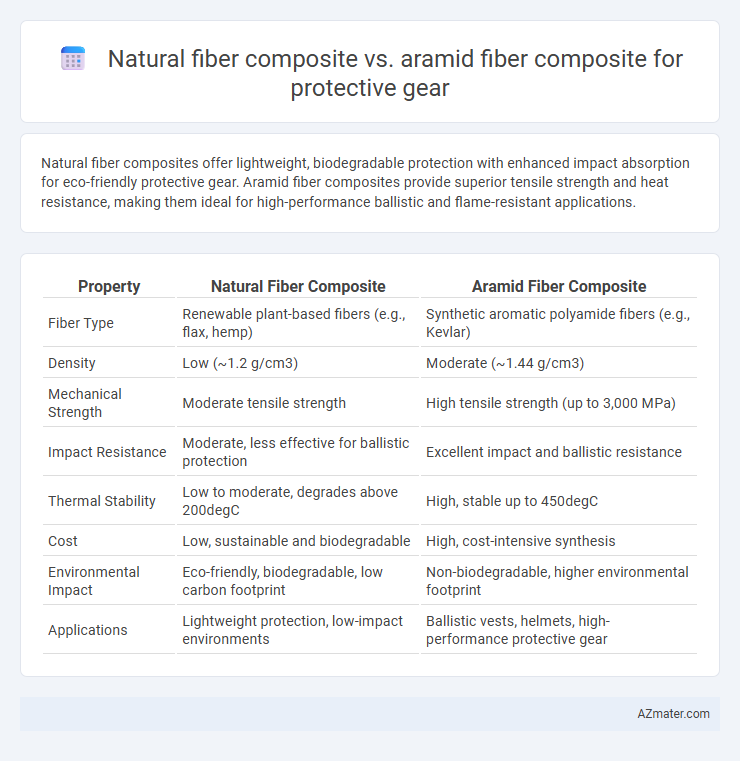Natural fiber composites offer lightweight, biodegradable protection with enhanced impact absorption for eco-friendly protective gear. Aramid fiber composites provide superior tensile strength and heat resistance, making them ideal for high-performance ballistic and flame-resistant applications.
Table of Comparison
| Property | Natural Fiber Composite | Aramid Fiber Composite |
|---|---|---|
| Fiber Type | Renewable plant-based fibers (e.g., flax, hemp) | Synthetic aromatic polyamide fibers (e.g., Kevlar) |
| Density | Low (~1.2 g/cm3) | Moderate (~1.44 g/cm3) |
| Mechanical Strength | Moderate tensile strength | High tensile strength (up to 3,000 MPa) |
| Impact Resistance | Moderate, less effective for ballistic protection | Excellent impact and ballistic resistance |
| Thermal Stability | Low to moderate, degrades above 200degC | High, stable up to 450degC |
| Cost | Low, sustainable and biodegradable | High, cost-intensive synthesis |
| Environmental Impact | Eco-friendly, biodegradable, low carbon footprint | Non-biodegradable, higher environmental footprint |
| Applications | Lightweight protection, low-impact environments | Ballistic vests, helmets, high-performance protective gear |
Introduction to Protective Gear Materials
Natural fiber composites, derived from materials such as hemp, flax, and jute, offer lightweight, renewable alternatives with good impact absorption properties for protective gear. Aramid fiber composites, featuring fibers like Kevlar and Twaron, provide superior tensile strength, high thermal resistance, and exceptional ballistic performance ideal for advanced body armor and helmets. Selecting protective gear materials involves balancing biodegradability, mechanical strength, and cost-effectiveness, where natural fibers excel in sustainability and aramid fibers dominate in high-performance protection.
Overview of Natural Fiber Composites
Natural fiber composites, derived from renewable resources such as hemp, flax, and jute, offer lightweight, sustainable alternatives for protective gear applications. These composites exhibit good impact absorption and vibration damping properties while maintaining lower production costs compared to synthetic fibers like aramid. However, natural fiber composites typically have lower mechanical strength and moisture resistance, which can limit their performance in high-impact or humid environments.
Understanding Aramid Fiber Composites
Aramid fiber composites, known for their exceptional tensile strength and high impact resistance, are widely used in protective gear such as bulletproof vests and helmets. These composites exhibit superior thermal stability and durability compared to natural fiber composites, making them ideal for high-performance safety applications. Their molecular structure enhances energy absorption, providing enhanced protection against ballistic and blunt force trauma.
Mechanical Properties Comparison
Natural fiber composites exhibit lower tensile strength and impact resistance compared to aramid fiber composites, which offer superior mechanical properties such as high tensile strength, excellent energy absorption, and exceptional toughness. Aramid fibers possess a high strength-to-weight ratio and outstanding fatigue resistance, making them ideal for protective gear demanding maximum durability and performance. Natural fibers are advantageous for lightweight and eco-friendly applications but typically do not match the superior mechanical resilience of aramid composites in high-impact protection scenarios.
Impact Resistance and Energy Absorption
Natural fiber composites exhibit lower impact resistance compared to aramid fiber composites, which offer superior toughness and high tensile strength ideal for protective gear. Aramid fibers, such as Kevlar, provide exceptional energy absorption through their molecular structure, effectively dissipating kinetic energy during impacts. Consequently, aramid fiber composites are preferred in high-performance protective applications where maximum impact resistance and energy absorption are critical.
Weight and Comfort in Protective Applications
Natural fiber composites offer significantly lower weight compared to aramid fiber composites, enhancing comfort for prolonged wear in protective gear applications. Their breathability and moisture-wicking properties contribute to improved ergonomic performance, reducing heat retention and skin irritation. In contrast, aramid fibers provide superior strength and impact resistance but tend to be heavier and less comfortable for extended use.
Environmental Sustainability of Materials
Natural fiber composites in protective gear offer significant environmental benefits through biodegradability and lower carbon footprints compared to aramid fiber composites, which are derived from petroleum-based synthetic polymers. Natural fibers such as hemp, flax, and jute require less energy-intensive processing and produce fewer greenhouse gas emissions during manufacturing. In contrast, aramid fibers, while superior in strength and durability, contribute to higher environmental impacts due to non-renewable resource extraction and limited recyclability.
Cost-Effectiveness Analysis
Natural fiber composites for protective gear offer significantly lower material and manufacturing costs compared to aramid fiber composites, making them an economically attractive option for budget-sensitive applications. Despite their lower price, natural fiber composites provide adequate impact resistance and durability for many standard protective uses, balancing cost savings with performance. In contrast, aramid fiber composites deliver superior strength and heat resistance but at a substantially higher cost, justifying their use primarily in high-risk, premium protection scenarios.
Real-World Applications and Case Studies
Natural fiber composites, such as those made from hemp or flax, are increasingly utilized in protective gear for applications requiring lightweight impact absorption and sustainability, demonstrated by their integration in motorcycle helmets and sports padding. Aramid fiber composites, particularly Kevlar, dominate ballistic protection in military and law enforcement gear due to their exceptional tensile strength, energy absorption, and flame resistance, with numerous case studies highlighting their effectiveness in bullet-resistant vests and helmets. Real-world comparisons underscore that while natural fiber composites offer cost-effective, eco-friendly solutions suitable for low to moderate threat environments, aramid composites remain the standard for high-risk scenarios demanding superior durability and protection.
Future Trends in Protective Gear Composites
Natural fiber composites offer sustainability and biodegradability, increasingly favored in eco-conscious protective gear development, while aramid fiber composites provide superior impact resistance and durability ideal for high-performance applications. Future trends emphasize hybrid composites combining natural and aramid fibers to optimize weight, cost, and protection levels. Innovations in nanotechnology and resin matrices aim to enhance mechanical properties and environmental resistance, driving the next generation of advanced protective gear materials.

Infographic: Natural fiber composite vs Aramid fiber composite for Protective gear
 azmater.com
azmater.com